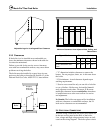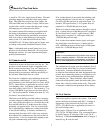
Modu-Fire
®
Gas-Fired Boiler Installation
5
3.0 INSTALLATION
3.1
RECEIVING AND STORAGE
3.1.1 Initial Inspection
Upon receiving the boiler, inspect it for signs of ship-
ping damage. Pay particular attention to the control
panel on the top of the boiler and the components
mounted on the back, which may show damage from
mishandling.
The exterior cabinet must be reasonably air-tight for
the burner to operate correctly. Leaks caused by dents
in the sheet metal or panels out of position may cause
the limit controls to show Low Air. Check to be sure
that the mixer core in the top burner is centered and
has not moved in shipment; (see Section 5.2, "Clean-
ing the Burner" for proper location). Verify that the
total number of pieces shown on the packing slip
agrees with those actually received.
Important: Note any damage or shortage on the
freight bill and immediately notify the carrier. File
all claims for shortage or damage with the carrier
.
3.1.2 Storage Prior to Installation
If the boiler is not installed immediately, it must be
stored in a location adequately protected from the
weather, preferably indoors. If this is not possible,
then it should remain in the shipping container and be
covered by a tarpaulin or other waterproof covering.
Note: Controls and other equipment that are damaged
or fail due to weather exposure are not covered by
warranty.
3.2
COMPLIANCE WITH CODES
The P-K MODU-FIRE
®
Boiler with standard compo-
nents and many options complies with American Na-
tional Standard/CSA Standard ANSI Z21.13/CSA 4.9,
latest edition, Gas-Fired Low Pressure Steam and Hot
Water Boilers. The heat exchanger is constructed and
stamped in accordance with ASME Boiler and Pres-
sure Vessel Code, Section IV for 160 psig maximum
operating pressure and/or 250º F maximum operating
temperature. Other codes or approvals which apply
will be labeled on the boiler.
Installation of the boiler must conform to all the re-
quirements of all national, state and local codes estab-
lished by the authorities having jurisdiction or, in the
absence of such requirements, in the U.S. to the Na-
tional Fuel Gas Code, ANSI Z223.1/NFPA 54, latest
edition. In Canada, the equipment shall be installed in
accordance with the current Installation Code for Gas
Burning Appliances and Equipment, CAN/CGA-
B.149, and applicable Provincial Regulations for the
class, which should be carefully followed in all cases.
Authorities having jurisdiction should be consulted
before installations are made.
Where required by local codes, the installation must
conform to American Society of Mechanical Engi-
neers Safety Code for Controls and Safety Devices for
Automatically Fired Boilers (ASME CSD-1).
In the Commonwealth of Massachusetts (a) this unit
must be installed by a licensed pipe fitter / plumber,
(b) field installed gas cocks must be "T" handle type,
and (c) piping of condensate shall conform with the
State Plumbing Code.
3.3
SETUP
3.3.1 Foundation
Provide a firm, level foundation, preferably of con-
crete.
Note: The boiler may be installed on a combustible
floor; however, the boiler must never be installed on
carpeting.
3.3.2 Placement
The boiler must be level to function properly. To as-
sist in leveling the boiler, the four (4) leg bolts (1/2"-
NC) holding the boiler to the shipping skid must be
reinstalled in the threaded legs on the bottom. The
adjustable legs are also necessary to provide adequate
floor clearance and prevent distortion on the cabinet,
(twisting, etc.) in addition to leveling.


















